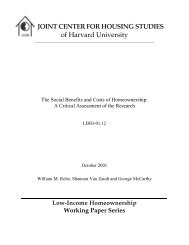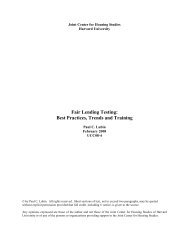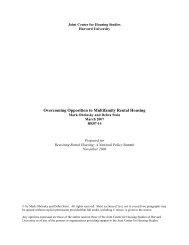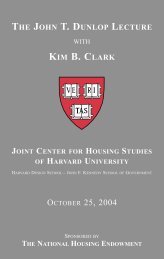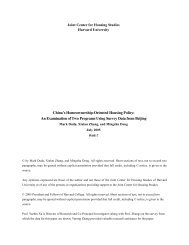Untitled - Joint Center for Housing Studies - Harvard University
Untitled - Joint Center for Housing Studies - Harvard University
Untitled - Joint Center for Housing Studies - Harvard University
You also want an ePaper? Increase the reach of your titles
YUMPU automatically turns print PDFs into web optimized ePapers that Google loves.
Data and Methodology<br />
In this paper we consider the efficiency of risk-based pricing in the non-con<strong>for</strong>ming<br />
mortgage market by studying the relative pricing of default risk. Default risk is measured by the<br />
borrower’s FICO score and LTV at the time the loan was originated and pricing efficiency is<br />
measured by the mortgage rate of the loan relative to the average rate at that time.<br />
Standard & Poor's proprietary database includes loan-level data on more than 9.3 million<br />
residential mortgages that have been analyzed since 1998 and used as collateral <strong>for</strong> rated<br />
mortgage-backed securities. For this study we include loans that meet the following criteria:<br />
• Fixed interest rate;<br />
• 30-year original term;<br />
• First liens;<br />
• Secured by single family detached owner occupied properties; and<br />
• First payment date of March, June, September, or December 1998-2003.<br />
The data are divided into subsets <strong>for</strong> Prime, Non-prime and Alt-A loans and we model<br />
each subset separately. These constraints minimize any potential variation in mortgage interest<br />
rates caused by factors other than those of particular interest <strong>for</strong> this study. The numbers of<br />
loans that make up the underlying data are 71,269 <strong>for</strong> Prime, 53,941 <strong>for</strong> Alt-A, and 86,487 <strong>for</strong><br />
Non-prime. We segregate the data into FICO score groupings and LTV groupings and calculate<br />
the average mortgage coupon <strong>for</strong> each group and origination period. We also extract the average<br />
mortgage loan size; loan balance data allow us to study the value of varying FICO scores.<br />
The FICO groups are defined as: 741-760, 721-740, 701-720, 681-700, 661-680, 641-<br />
660, 621-640, 601-620, and 581-600, and the LTV groups are defined as: 69-71, 74-76, 79-81,<br />
84-86, 89-90, and 94-96. Thus each period’s data creates a 9 x 6 two-way table where the value<br />
in each cell of the table represents the average mortgage coupon <strong>for</strong> the loans in that group.<br />
11



